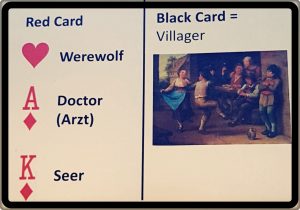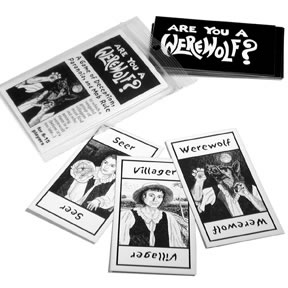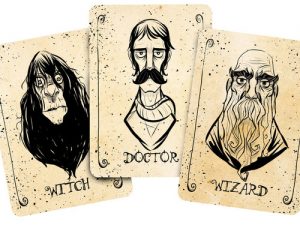
A year ago, I stayed with a group of friends in a castle in the remote Scottish Highlands. One night after dinner, I turned a werewolf. And I loved it!
Fast-forward a year and the bunch of us still regularly meet to play Werewolf. We throw a quick buffet dinner beforehand, sometimes invite a few newbies to the game, and the party is on! It never fails to be a fun successful night. It is also a great opportunity for me to play around with recipes for a mini-kitchen invasion…
So what do we play? A psychological game involving strategic thought, deduction and team work. Dmitry Davidoff created it in 1986 in USSR as the Mafia Game before switching the name to Werewolf Game in 1996 to give it a less cultural and stereotyped theme.  The model is a conflict between a dangerous informed minority, the werewolf pack, and an uninformed majority, the innocent villagers. One villager is killed every ‘night’ by the werewolves, and the surviving villagers must debate by ‘day’ who the werewolves are and vote eliminate the suspect. The play lasts until either the villagers have identified and convicted to death all the werewolves, or until the werewolves outnumber the villagers.
The model is a conflict between a dangerous informed minority, the werewolf pack, and an uninformed majority, the innocent villagers. One villager is killed every ‘night’ by the werewolves, and the surviving villagers must debate by ‘day’ who the werewolves are and vote eliminate the suspect. The play lasts until either the villagers have identified and convicted to death all the werewolves, or until the werewolves outnumber the villagers.
It sounds simple enough and it is, although you need a set-up and a few rules. The first and most important one is: do not cheat! If you do, you are ruining the whole game for everyone including for you, so what is the point.
Set-up
Assemble a group of players, with 7 to 17 players and a moderator (the moderator can change between each game). Off numbers are best, though it is not compulsory; you may have more players than 17 but you take the risk into the game turning into chaos.
Determine the roles
Each player receives a card, which must remain secret, indicating if he is a villager, a werewolf, a doctor or a seer.
 The moderator is the narrator and impartial referee of the game. He is neutral and is essential to the game.
The moderator is the narrator and impartial referee of the game. He is neutral and is essential to the game.
The Gameplay
The game proceeds in alternating phases of day and night, and the flow is run by the moderator. It is crucial that all actions by players at night be performed silently, otherwise the identities of the werewolves, seer, or other roles can be revealed.
 The moderator will indicate to the players it is night by asking them all to close their eyes (and not to cheat!).
The moderator will indicate to the players it is night by asking them all to close their eyes (and not to cheat!). The villagers then start investigating, analyzing body behavior, facial reactions, accusations, defenses etc.
The villagers then start investigating, analyzing body behavior, facial reactions, accusations, defenses etc.
Important details
 A dead villager can only express his opinions and participate to the debate on the day after his death, as afterward the dead can keep their eyes open at night and know who is who. They must then be careful not to reveal or indicate what they know to anyone.
A dead villager can only express his opinions and participate to the debate on the day after his death, as afterward the dead can keep their eyes open at night and know who is who. They must then be careful not to reveal or indicate what they know to anyone. Werewolves are liars. They lie about not being werewolves, and they may lie about allegiances, being the seer or the doctor etc.
Werewolves are liars. They lie about not being werewolves, and they may lie about allegiances, being the seer or the doctor etc.
It might look a little complex at first, but I assure you, the game is fairly simple in practice. All the fun is its psychological side. People will surprise you with their strategies, bluffs, deductions, and interactions. Really, you should try!
Thank you for reading, and have fun!
Yours, Virginie
